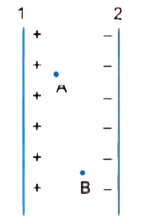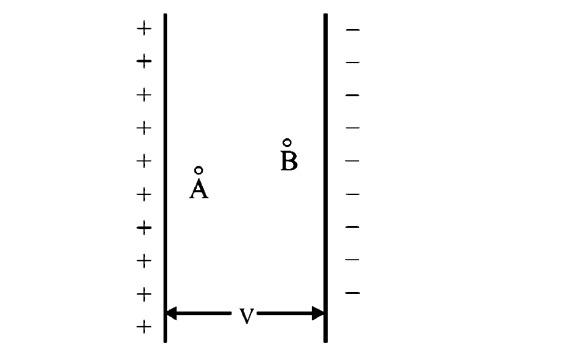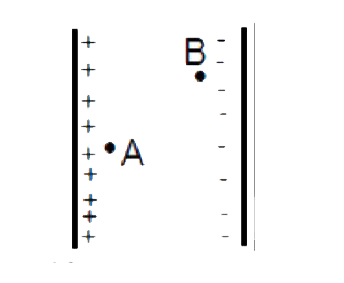Two protons A and B are placed in between the two plates of a parallel plate capacitor charged to a potential difference Vas shown in Fig. The force on the two protons are exactly the same.

True – Force on the two protons are equal because electric field is uniform between the plates of capacitor.
Topper's Solved these Questions
- ELECTROSTATIC POTENTIAL AND CAPACITANCE Book:U-LIKE SERIESChapter:ELECTROSTATIC POTENTIAL AND CAPACITANCE Exercise:ASSERTION-REASON TYPE QUESTIONS
Explore 5 Videos
- ELECTROSTATIC POTENTIAL AND CAPACITANCE Book:U-LIKE SERIESChapter:ELECTROSTATIC POTENTIAL AND CAPACITANCE Exercise:VERY SHORT ANSWER QUESTIONS
Explore 40 Videos
- ELECTROSTATIC POTENTIAL AND CAPACITANCE Book:U-LIKE SERIESChapter:ELECTROSTATIC POTENTIAL AND CAPACITANCE Exercise:FILL IN THE BLANKS
Explore 18 Videos
- ELECTROMAGNETICE INDUCTIONBook:U-LIKE SERIESChapter:ELECTROMAGNETICE INDUCTIONExercise:Self Assessment Test Section -D
Explore 1 Video
- EXAMINATION PAPER 2020 (SOLVED)Book:U-LIKE SERIESChapter:EXAMINATION PAPER 2020 (SOLVED)Exercise:SECTION D
Explore 6 Videos
Similar Questions
Two protons A and B are placed in between the two plates of a parallel plate capacitor charged to a potential difference V as shown in the figure. The forces on the two protons are identical.

View SolutionTwo protons A and B are placed in between the two plates of a parallel plate capacitor charged to a potential difference V as shown in the figure. The forces on the two protons are identical.

View Solution
Knowledge Check
A proton is first placed at A and then at B between the two plates of a parallel plate capacitor charged to a P.D. of V volt as shown. Then force on proton at A is -
 Amore than at BBless then at BCequal to that at BDnothing can be said
Amore than at BBless then at BCequal to that at BDnothing can be saidThe plates of a parallel plate capacitor are, not exactly parallel. The surface charge density therefore :
Ahigher at the closer endBthe surface charge density will not be uniformCeach plate will have the same potential at each point.Dthe electric field is smallest where the plates are closest.If a thin metal foil of same area is placed between the two plates of a parallel plate capacitor of capacitance C, then new capacitance will be
ACB2CC3CD4C
How will the voltage (V) between the two plates of a parallel plate capacitor depend on the distance (d) between the plates, if the charge on the capacitor remains the same?
View SolutionThe plates of a parallel plate capacitor are not exactly parallel. The surface charge density is therefore,
View SolutionIf a thin metal foil of same area is placed between the two plates of a parallel plate capacitor of capacitance C, then new capacitance will be
View SolutionThe force between the plates of a parallel plate capacitor of capacitance C and distance of separation of the plates d with a potential difference V between the plates, is.
View SolutionThe plates of a parallel plate capacitor are, not exactly parallel. The surface charge density therefore :
View Solution
